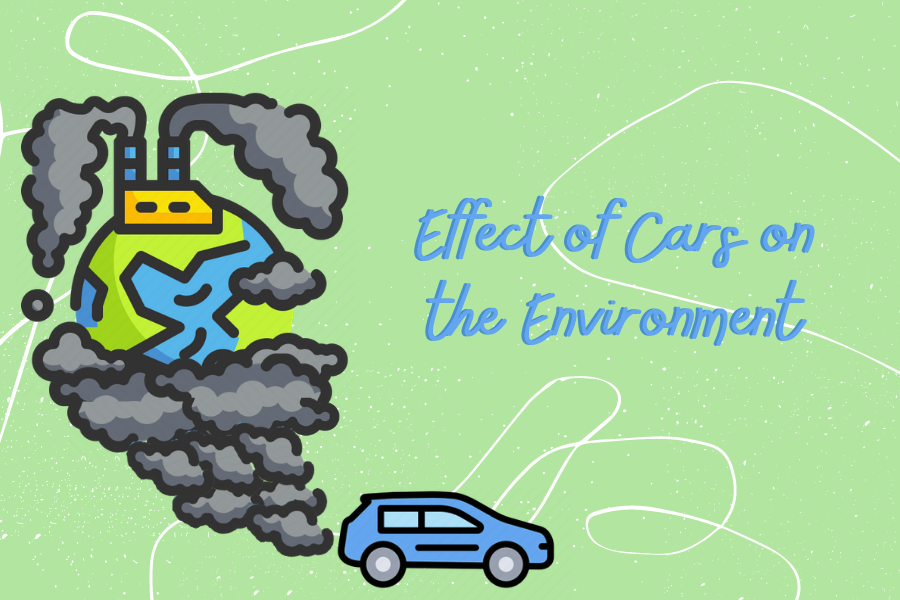Effect of Cars on the Environment
Building cars
When people think of cars harming the environment, they often think about the damage that cars cause while they are being used. However, cars also harm the environment while they are being made. The emissions caused by car manufacturing can be up to four times higher than emissions that are created when that car drives 100,000 miles. These vehicles require steel, rubber, glass, plastics, paints, and a variety of other materials when being manufactured. Some of these resources have to be dug out of the ground and then extracted. Consequently, these materials do not break down for thousands of years, and substances such as plastics and toxic battery acids stay in our environment. If we continue to pollute the environment with these materials, we will create irreversible damage.
The extracting, shipping, and burning of petroleum
Most of a car’s environmental impact is due to the greenhouse gases that cars emit while a person is driving. Petroleum is burned to create energy so that the car can move. However, this chemical is extremely harmful to the environment, both as a result of its use and its extraction. Extracting petroleum from the earth requires a lot of energy and damages local ecosystems. If an ecosystem gets in the way of petroleum extracting machines, the ecosystem is destroyed, therefore contributing to the immense loss of natural habitat around the world. Also, shipping petroleum all over the world requires energy and can damage the oceans. Ships, just like cars, need energy to move, and the energy ships use are not eco-friendly. Using this mode of transport to transfer petroleum also creates the risk of an oil spill. These oil spills kill thousands of animals and destroy ecosystems that take a long time to naturally rebuild. When burning petroleum to make energy, cars create harmful emissions, as smog, carbon monoxide, and other toxic gasses are released through tailpipes. This pollutes our atmosphere and can be deadly for humans to breathe in.
How can you help protect the environment?
Due to the harmful effects on the environment caused by cars, it is important to try and implement tips into one’s everyday life that make the process of using and maintaining a vehicle more sustainable. Cars, if maintained properly and regularly inspected, can last much longer. If people make their cars last longer and purchase new ones less frequently, the need for new car production will decrease, therefore lowering the impact of the energy-heavy and polluting process of car manufacturing. Keeping cars in good condition can lower the negative impact they make on our environment by making them more energy efficient. This includes having one’s tires checked because if they aren’t properly inflated, gas mileage will decrease and more pollutants will be emitted. Tires can be easily checked using a pressure gauge. Which car you own can also greatly affect your individual impact on the environment, and choosing to purchase a fuel efficient vehicle can make a large difference. There are many factors that make a car fuel efficient, such as whether it is powered by electricity versus gasoline, the materials from which the car is made, its weight, the efficiency of the engine and many more. Oftentimes, people tend to focus on the impact of the physical car, but the driver and their driving style can be very important as well. Speeding up quickly and slamming on the brakes can emit more greenhouse gases and worsen gas mileage. Additionally, it is very important to refrain from idling. Idling pollutes the air, wears out the engine and unnecessarily wastes fuel. When possible, using something other than your personal vehicle to get places can benefit the environment. This includes using public transportation, car pooling, telecommuting, walking, and biking. All of these alternatives can reduce greenhouse gas emissions.
What are the downsides of the current car alternatives?
While there are many great options to help the environment such as keeping cars longer and turning to other transportation alternatives, there are of course also many downsides. Maintaining an older car can be costly. In addition, older cars tend t0 be less energy efficient than newer models, so buying a new more energy-efficient vehicle can sometimes be a better option. Although building new cars uses energy, maintaining old cars and building replacement parts does as well. Purchasing more environmentally-friendly electric and hybrid cars can be very expensive. Taking public transportation every day can also be costly and less convenient. The time it takes to walk or bike will increase the time it takes to get places. Despite these inconveniences, it is important to remember the catastrophic threat of climate change and global warming. Switching to these alternatives is worth the benefit, as we want to continue inhabiting Earth for many years.
Sources:
Bater, Emily. “The Environmental Pros and Cons of Electric Cars.” Admiral, Admiral, 22 Oct. 2020, www.admiral.com/magazine/guides/motor/the-environmental-pros-and-cons-of-electric-cars.
“Manufacturing a Car Creates as Much Carbon as Driving It.” The Guardian, Guardian News, and Media, 23 Sept. 2010, www.theguardian.com/environment/green-living-blog/2010/sep/23/carbon-footprint-new-car.
“Routes to Lower Greenhouse Gas Emissions Transportation Future.” EPA, Environmental Protection Agency, 15 Oct. 2019, www.epa.gov/greenvehicles/routes-lower-greenhouse-gas-emissions-transportation-future.
Staff, National Geographic. “The Environmental Impacts of Cars Explained.” Environment, National Geographic, 3 May 2021, www.nationalgeographic.com/environment/article/environmental-impact.










